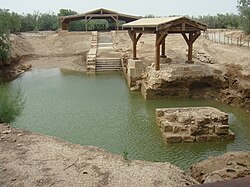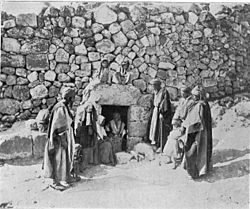Bethany



Bethany (Greek: Βηθανία Bethania; Hebrew: בית עניה bait 'oni "house of poverty" or also "house of death"; from Hebrew: עֹנִי 'oni "poverty") is the name of two different places in Palestine mentioned in the New Testament.
The place of the Jordan baptism
Bethany Beyond the Jordan, first mentioned in the Gospels, situated on the eastern bank of the Jordan in what is now Jordan at almost the lowest point of the solid earth[1], was, according to John 1:28, the place where the Jordan baptism of Jesus of Nazareth took place, by which he received the sun-spirit of the Christ into his bodily sheath.
„The Testimony of John the Baptist
19 And this is the testimony of John, when the Jews sent priests and Levites from Jerusalem to ask him, “Who are you?” 20 He confessed, and did not deny, but confessed, “I am not the Christ.” 21 And they asked him, “What then? Are you Elijah?” He said, “I am not.” “Are you the Prophet?” And he answered, “No.” 22 So they said to him, “Who are you? We need to give an answer to those who sent us. What do you say about yourself?” 23 He said, “I am the voice of one crying out in the wilderness, ‘Make straight the way of the Lord,’ as the prophet Isaiah said.” 24 (Now they had been sent from the Pharisees.) 25 They asked him, “Then why are you baptizing, if you are neither the Christ, nor Elijah, nor the Prophet?” 26 John answered them, “I baptize with water, but among you stands one you do not know, 27 even he who comes after me, the strap of whose sandal I am not worthy to untie.” 28 These things took place in Bethany across the Jordan, where John was baptizing.
Behold, the Lamb of God
29 The next day he saw Jesus coming toward him, and said, “Behold, the Lamb of God, who takes away the sin of the world! 30 This is he of whom I said, ‘After me comes a man who ranks before me, because he was before me.’ 31 I myself did not know him, but for this purpose I came baptizing with water, that he might be revealed to Israel.” 32 And John bore witness: “I saw the Spirit descend from heaven like a dove, and it remained on him. 33 I myself did not know him, but he who sent me to baptize with water said to me, ‘He on whom you see the Spirit descend and remain, this is he who baptizes with the Holy Spirit.’ 34 And I have seen and have borne witness that this is the Son of God.“
On the site where the biblical Bethany is believed to have been, there is now the archaeological site of Al-Maghtas (Arabic المغطس, DMG al-maġṭas ‚the baptismal site‘), which was listed as a UNESCO World Heritage Site in Jordan in 2015.
Home of Lazarus


The second Bethany was located about 15 stadia[2] (just under 2.8 km) southeast of what was then Jerusalem on the eastern slope of the Mount of Olives. According to John 11:18, it was the home of the three siblings Mary, Martha and Lazarus and it was here that the raising of Lazarus took place. In this Bethany, which was later called Lazarion and probably corresponds to today's Al-Eizariya (Arabic العيزريه; Hebrew: אלעיזריה), a tomb of Lazarus, where the raising is said to have taken place, was named as early as the 4th century, over which, according to Jerome, a church was already built at that time. According to Mt 26:6 LUT, the house of Simon the leper was also located in Bethany.
„The place at the Jordan where John the Baptist baptised and where the baptism of Jesus by the Baptist also took place is called Bethany in John's Gospel (John 1:28 LUT), as is the place near Jerusalem where the central event of the Gospel, the raising of Lazarus, took place. Bethany is called the "house of poverty". Actually, the whole of Judea is one big Bethany, if you compare it with the ethereally rich landscape of Galilee. One Bethany is up on the edge of the desert of Judah as you make your way down from the Mount of Olives to Jericho. The other Bethany must have been down at the edge of the desert by the Jordan. The whole desert of Judah is framed by the name "house of poverty". And the Gospel of John points to these connections as if with an outstretched finger. This is especially the case where Jesus, before the last decisive Easter, descends once more to the place of baptism where John the Baptist had worked (John 10:40 LUT). There he is met by the news of Lazarus' illness (John 11:3 LUT). And so the way of Jesus described at the beginning of the 11th chapter is the way from one Bethany to the other Bethany. One is thus right in the centre of the meaning of Judea and the incarnation of the Christ in Judea.“ (Lit.: Bock, p. 746)
Bethphage

Bethphage (Greek: Βηθφαγή; Aramaic: בית פגי "house of (unripe) figs") is a place in Palestine mentioned in the New Testament, located on the Mount of Olives in the immediate vicinity of Bethany[2], where the raising of Lazarus took place, about halfway to Jerusalem. From here the disciples fetched the donkey on which the Christ entered Jerusalem on Palm Sunday to the cheers of the crowds (Matthew 21:1–11, Mark 11:1–11, Luke 19:28–40, John 12:12–19). The donkey is a symbol for the physical body of man, which is also often used in fairy tales (cf. for example The Town Musicians of Bremen). In Bethphage there was also the fig tree, which withered forever the following day at the word of the Christ (Matthew 21:18–22, Mark 11:12–14, → cursing the fig tree). The figs are an occult reference to the powers of the old natural clairvoyance, which should now dry up to make way for faith, with which the seed of a renewed, no longer dream-conscious but completely self-conscious vision is planted in the soul; then the fig trees will sprout anew and announce that the kingdom of God is near (Luke 21:29–30).
Literature
- Emil Bock: Das Evangelium. Betrachtungen zum Neuen Testament., Urachhaus Verlag, Stuttgart 1984
References
- ↑ The lowest point on the solid earth, 420 m below sea level, is where the Jordan River flows into the Dead Sea. The Jordan Rift Valley is part of the Great African Rift Valley, which is the "deepest and most conspicuous scrape on the face of the earth".
- ↑ Not to be confused with the Bethany where, according to the biblical account, the Jordan baptism took place.
